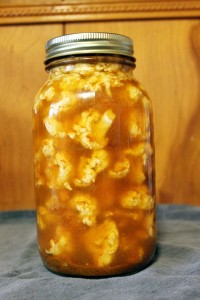Lacto-Fermented Vegetables
Stephanie Kelley

I’d always been a bit intimidated by the idea of fermenting my own food but once I started I began to realize that the process is far easier and simpler than I ever imagined! And the results are supremely tasty.
As I continued my research, I discovered that before the advent of modern day canning most of our ancestral fore mothers understood the process of lacto-fermentation. They had crocks of real sauerkraut, lacto-fermented cucumber pickles and other treasures such as beets, onions or garlic waiting out the winter in the root cellar.
Countries with histories deeper than our own also traditionally fermented vegetables with simply salt, water and spices – knowing that the lactic acid produced would prevent the putrefaction of these precious nutritional storehouses, keeping them fed through winter. When we lost touch with this food preservation technique we also lost touch with the unparalleled health benefits that came with them.
The proliferation of lactobacilli in fermented vegetables enhances their digestibility and increases vitamin levels. These beneficial organisms produce numerous helpful enzymes as well as antibiotic and anti -carcinogenic substances. Their main by-product, lactic acid, not only keeps vegetables and fruits in a state of perfect preservation but also promotes the growth of healthy flora throughout the intestine.
I found the kimchi so addictive that I have been making dishes that go well with the stuff, planning my meals to accompany the kimchi! So, the other night I planned to make a batch of curried garbanzo beans with cauliflower. When I got home with a new head of cauliflower, I discovered I still had cauliflower in my fridge….an overabundance of the vegetable. I figured I could probably ferment this new head and so began looking for a likely looking recipe. I soon came upon this formula for Lacto-Fermented Curried Cauliflower.
I immediately made a batch…the one head of florets fit perfectly into a one litre sized canning jar as you can see in my not so professional photo!
- 1 small head of cauliflower (about 3 cups of small florets)
- 2-1/2 tablespoons curry powder of choice (make it spicy!)
- 4 cloves of garlic, smashed and peeled
- 3 tablespoons sea salt
- 1 quart of water
Instructions
1. Make a brine by heating up the water, adding the salt, and allowing it to dissolve. Allow to cool to room temperature.
2. Cut the cauliflower into small florets, for a total of about 3 cups.
3. Place the garlic cloves in the bottom of the jar. Add the curry powder followed by the cauliflower. Pour the brine over the vegetables until they are covered, leaving 1-1/2 inches of head space. Place a lid on and shake well to dissolve curry powder.
4. Place cover on jar and allow to sit out at room temperature for 3 to 7 days until fermented. You may have to burp the jar for the first few days to release pent-up gases. To do this simply open the jar until any pressure is released and immediately retighten.
Once you are satisfied that your cauliflower is fermented you can move it to cold storage and enjoy!
